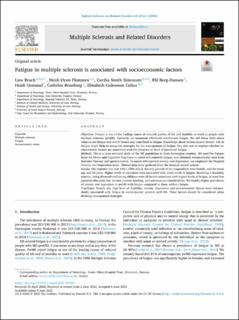| dc.contributor.author | Broch, Line | |
| dc.contributor.author | Flemmen, Heidi Øyen | |
| dc.contributor.author | Simonsen, Cecilia Smith | |
| dc.contributor.author | Berg-Hansen, Pål | |
| dc.contributor.author | Ormstad, Heidi | |
| dc.contributor.author | Brunborg, Cathrine | |
| dc.contributor.author | Celius, Elisabeth Gulowsen | |
| dc.date.accessioned | 2022-12-02T12:39:17Z | |
| dc.date.available | 2022-12-02T12:39:17Z | |
| dc.date.created | 2022-07-13T11:53:25Z | |
| dc.date.issued | 2022 | |
| dc.identifier.citation | Broch, L., Flemmen, H. Ø., Simonsen, C. S., Berg-Hansen, P., Ormstad, H., Brunborg, C. & Celius, E. G. (2022). Fatigue in multiple sclerosis is associated with socioeconomic factors. Multiple Sclerosis and Related Disorders, 64, Artikkel 103955. | en_US |
| dc.identifier.issn | 2211-0348 | |
| dc.identifier.uri | https://hdl.handle.net/11250/3035644 | |
| dc.description.abstract | Objectives: Fatigue is one of the leading causes of reduced quality of life and inability to work in people with multiple sclerosis (pwMS). Currently, no treatment effectively ameliorates fatigue. We still know little about what causes fatigue and which factors may contribute to fatigue. Knowledge about socioeconomic factors’ role in fatigue might help us recognize strategies for the management of fatigue. Our aim was to explore whether socioeconomic factors are associated with the presence or level of perceived fatigue.
Methods: This is a cross-sectional study of the MS population in three Norwegian counties. We used the Fatigue Scale for Motor and Cognitive Functions to assess self-reported fatigue, and obtained socioeconomic data from Statistics Norway and questionnaires. To assess self-reported anxiety and depression, we employed the Hospital Anxiety and Depression Scale. Clinical data were gathered from the hospital record system.
Results: The response rate was 64% (1599/2512). Seventy percent of the respondents were female, and the mean age was 52 years. Higher levels of education were associated with lower levels of fatigue. Receiving a disability pension, being divorced and having children were all factors associated with higher levels of fatigue, as were low parental education, low income, current smoking, and autoimmune comorbidities. We found a higher prevalence of anxiety and depression in pwMS with fatigue compared to those without fatigue.
Conclusion: Female sex, high level of disability, anxiety, depression and socioeconomic factors were independently associated with fatigue in contemporary patients with MS. These factors should be considered when devising management strategies. | en_US |
| dc.language.iso | eng | en_US |
| dc.rights | Navngivelse 4.0 Internasjonal | * |
| dc.rights.uri | http://creativecommons.org/licenses/by/4.0/deed.no | * |
| dc.title | Fatigue in multiple sclerosis is associated with socioeconomic factors | en_US |
| dc.type | Peer reviewed | en_US |
| dc.type | Journal article | en_US |
| dc.description.version | publishedVersion | en_US |
| dc.rights.holder | © 2022 The Authors. | en_US |
| dc.source.pagenumber | 9 | en_US |
| dc.source.volume | 64 | en_US |
| dc.source.journal | Multiple Sclerosis and Related Disorders | en_US |
| dc.identifier.doi | https://doi.org/10.1016/j.msard.2022.103955 | |
| dc.identifier.cristin | 2038204 | |
| dc.source.articlenumber | 103955 | en_US |
| cristin.ispublished | true | |
| cristin.fulltext | original | |
| cristin.qualitycode | 1 | |

